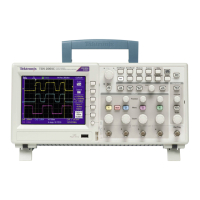Performance Verification
The Ext Trig inp
ut will also be receiving approxima tely 200 mV
p-p
. Small
deviations from the nominal 200 mV
p-p
oscilloscope display are acceptable.
7. Set the leve le d sine wave g ene rator frequency to:
40 M Hz if you are checking a TDS1001C-EDU
50 M Hz if you a re checking a TDS2001C
60 M Hz if you are checking a TDS1002C-EDU
70 MHz if you are checking a TDS2002C, or TDS2004C
100 MHz if you are checking a TDS1012C-EDU, TDS2012C, TDS2014C,
TDS2022C, or TDS2024C
8. Set the oscilloscope Horizontal Scale (seconds/division) to 5ns/div.
9. Push Set To 5 0%. Adjust Trigger Level as ne ces sary and then check that
triggering is stable.
10. For TDS2022C and TDS2024C models, set the sine wave generator output
level for a channel 1 display to approximately 350 mV
p-p
.
11. For TDS2022C and TDS2024C models, set the sine wave generator frequency
to 200 MHz.
12. Set the oscilloscope Horizontal Scale (seconds/division) to 2.5 ns/div.
13. Push Set To 50%. Adjust Trigger Level as necessary and then check that
triggering is stable.
14. Change the oscilloscope setup using the following table:
Push menu button Select menu option Select setting
Trig Menu
Slope
Falling
15. Push Set To 50%. Adjust Trigger Level as necessary and then check that
triggering is stable.
16. Disconnect the test setup.
Check Vertical Position
Accuracy
The results of this test and the DC Gain Accuracy test together define the DC
Measurement Accuracy of the oscilloscope. The DC Measurement Accuracy
specification encompasses two different ranges of operation over two different
attenuator settings.
DC Gain Accuracy: Ide
ntifies errors, m ostly from the A/D converter,
when the vertical position (known as offset in these oscilloscopes) is set to
0 divisions (or a grounded input will show screen center)
Vertical Position Accuracy: Identifies errors, mostly fr om the position control,
made when the vertical position is set to a non-zero value
36 TDS2000C and TDS1000C-EDU Series Oscilloscope Service Manual

